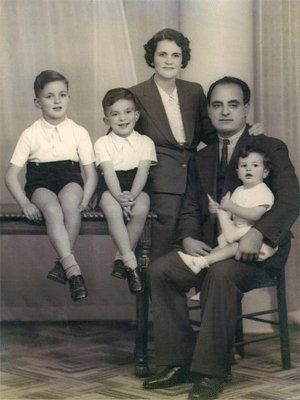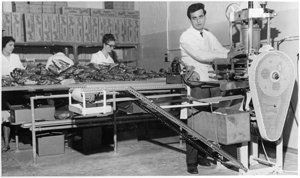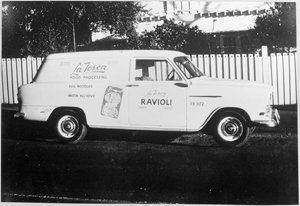Our History
The early years
Nello and Bruna Borghesi, the founders of La Tosca
pasta, immigrated to Melbourne from the region of
Tuscany in Italy in 1929. They settled in Collingwood
during the Depression, and Nello made alabaster statues
from moulds he had brought out from Italy which were
sold around Victoria by a relative.
During the 1930s, with fellow Italian migrant Camillo Triaca, Nello opened Café Latin in Exhibition Street, followed by La Scala and La Tosca cafes. The menus still held by the family reveal a mixed menu of local and Italian fare.
During World War II, anti-Italian sentiment led Nello to close La Tosca (the Latin having closed years ago) and rename La Scala The Hoddle Café. The family moved to Daylesford at this time to escape being labelled as
‘enemy aliens’.

Nello and Bruna Borghesi with their Australian-born sons
Bartolomeo, Raimondo and Lionello (Lio), 1939. Source: The
Borghesi Family
La Tosca is born
In 1947, having closed The Hoddle, Nello began La
Tosca Food Processing Company at 12 Bennetts Lane in
the city. With the exception of a relocation to Brunswick in
1972, the business has operated continuously ever since.
La Tosca produced tomato concentrate, tinned tuna,
asparagus and peppers, as well as a bolognese sauce
under the label of ‘Sugodoro’ (‘golden sauce’). The
tomato paste was the most popular product and was
predominantly sold to Italian delis and restaurants to
make the base for their sauces. The vegetables were
supplied by Victoria Market and tomatoes from Werribee
market gardens.
In 1952 the production of the canned vegetable products
ceased and only the tomato sauce line of Sugodoro
continued. This was due to the competition of large
companies such as Heinz and Campbells, with which the
family could never hope to compete with on a massproduction
scale.
In 1952 Nello began the production of fresh ravioli under
the label of La Tosca Pasta. Ravioli, considered a
specialty product, and only made for special occasions,
was the first pasta product the family made at home. The
Borghesi’s would work together to the roll the pasta by
hand, using a wooden ravioli roller to stamp the ravioli
pockets into the pasta sheets. Around 1957, the family
invested in a ravioli machine, purchased from a Greek
restaurant in Swanston Street.

Lio Borghesi at the pasta machine at La Tosca factory in
Bennetts Lane, Melbourne, about 1969.
Source: Borghesi family and the Italian Historical Society
COASIT
The Borghesi’s found it challenging at first to introduce
the pasta to the Anglo-Australian consumers.
The Italian-
Australian market also had to be convinced that the
product was as good as that which they could make
themselves. The pasta would be made in the mornings,
then delivered in the afternoons in the family van.
It was a very labour intensive process and the whole family would help in the production. Deliveries were made to most
Melbourne Italian food outlets and restaurants, such as
Florentino’s, The Latin, and Marios.
By the 1960s, the
clientele grew to catering for weddings and non-Italian
cafes, and then the business really took off. In the 1960s,
the delivery of dry pasta was replaced by frozen products.

This van delivered trays of freshly made pasta from La Tosca to
customers in and around inner Melbourne, about 1960.
Source: Borghesi family and Italian Historical Society COASIT
Nello Borghesi died in 1961 and Bruna and the younger
son Lio continued to run the business.
Small migrant businesses
Small businesses have been the mainstay of countless
Melbourne families and the heart of many communities,
such as butchers and tailors, greengrocers, restaurants,
and fish and chip shops. In terms of the Italian
community, countless cafes, restaurants, delis, grocers
and small food companies were flourishing around inner
Melbourne from the 1920s, and particularly around time
the Borghesi’s were setting up La Tosca Pasta during the
late 1940s and 1950s.
Post-war migrants, especially those from southern
Europe, embraced the opportunity to run small
businesses. They could get a start without large amounts
of capital, special skills or English proficiency. These
enterprises not only provided work for extended families,
but gave service and character to their neighbourhoods.
By the 1970s, supermarkets were starting to compete
with the local specialist stores, while food production was
shifting to light industrial precincts on Melbourne’s
outskirts. Today, milk bars and family-run factories, once
such a feature of Melbourne’s inner suburbs, are now few
and far between. But La Tosca has endured.
Visitor Information
The La Tosca story and a selection of the early pasta-making tools and product labels are
on display in The Melbourne Story (/melbournemuseum/whatson/current-exhibitions/
exhibition at Melbourne Museum (/melbournemuseum/).
Follow Us
Call Us Now!La Tosca Foods
92-100 Holmes Street
Brunswick VIC 3056
(03) 9384 6622
Website by
Melbourne IT
